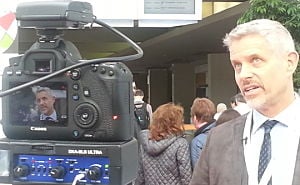 Several times a month reporters and writers ask me questions about physician burnout.
Several times a month reporters and writers ask me questions about physician burnout.
Many times they are the same questions - natural, logical, seemingly simple questions about burnout in physicians.
It does make sense that they would ask me in particular. I have ten years, 175 organizations and over 40,000 doctors experience in coaching and training people to recognize and prevent physician burnout.
With that background many reporters think I can rattle off the answers in a way that wraps a bow on the whole issue. They don't understand two key points.
- Burnout kills doctors and patients. It must be respected and taken seriously.
- Burnout is never simple and straightforward. You must respect the complexity of the issues that come together to burn out 40 - 50% of US Physicians on any given work day.
So let me answer the first four questions I always get - with the proper respect and honoring the complexity of this issue.
Let's start to put together a Frequently Asked Question (FAQ) file for this whole topic.
============
PHYSICIAN BURNOUT FAQ:
What are the warning signs of burnout?
How has COVID-19 impacted physician burnout?
Why is it important to address burnout rather than just power through?
What specific actions can I take to address or prevent physician burnout?
============
1) What are some of the warning signs that you’re experiencing burnout as a healthcare provider?
The 3 core symptoms of burnout come from the industry standard test for physician burnout, the Maslach Burnout Inventory, named for industrial psychologist Christina Maslach.
1) Physical and emotional exhaustion. The little voice in your head might say, "I'm not sure how much longer I can go on like this."
Family members closest to you will notice this and be concerned. You may be short tempered, tearful and notice your performance is not its best.
Even if you are not a doctor, you may recognize that little voice of exhaustion because every parent has said the same thing at one time or another.
2) Cynical and sarcastic, suffering from Compassion Fatigue especially towards difficult patients.
3) Doubting the meaning of your work. Christina Maslach called this "lack of efficacy". Your little voice might say something like, "What's the use."
When you are deep in burnout you dread going to work and the little voice might say something like this - and this is a huge red flag - "Maybe if I am lucky, I will get hit by a car on the way to work today and I won't have to see patients."
============
2) How has the COVID-19 pandemic impacted burnout in healthcare providers?
COVID-19 has made everything worse for physicians, at work and at home.
It has overwhelmed and traumatized many doctors and staff - those dealing directly with sick patients. We know from previous experience with epidemics there will be a long tail of psychiatric complications among these workers for years to come. Things like depression, alcohol, drugs and suicide.
Doctors themselves have become ill and some have died. Dr. Lorna Breen is the most widely known physician casualty of the Pandemic.
Some families have split up to live in different houses/apartments so that the doctor
can avoid bringing the infection home to the family members. Even despite these precautions some family members have become infected and died.And this overwhelmed group are only 1/3 of the physicians and staff in our healthcare system. The rest - 2/3 of the doctors and staff members - saw a dramatic slowdown in their practices while their colleagues were overwhelmed in the ICU and Emergency Department. Many practices ground to almost a complete halt between March and July and are still not back at full volume.
The healthcare industry has suffered massive losses in the 2nd quarter of 2020 with income down 40 - 60%. There have been pay cuts, layoffs and more.
And the pandemic combined with social unrest and the elections means there it is much more difficult to recharge and recuperate from the normal energy drain of a normal medical practice. You certainly can't turn on the TV and just kick back, even sports are not the same.
============
3) Why is it important to address burnout? What’s the harm of “powering-through”
Physician burnout kills doctors and kills patients.
Burnout is connected to depression, drug addiction, alcoholism and suicide in physicians. Even in non-pandemic times physician suicide rates are twice those of non-physicians.
Physician burnout is linked to lower care quality and safety, lower patient satisfaction and higher medical error and malpractice rates.
And when your energy reserves are below normal, there is no such thing as powering through.
============
4) Are there specific actions I can put into place to address burnout for myself and colleagues?
There are hundreds of specific actions doctors and organizations can take to lower the stress on the patients and staff and prevent burnout. Our MATRIX 2.0 Report White Paper contains 235 stress lowering tools.
That may seem confusing if you think burnout is "a problem".
You may ask yourself, which one of those is "the solution" to burnout. If you use problem/solution language you are falling into two of the three big myths about burnout.
Burnout is not a problem. There is no solution. Burnout does not meet the definition criteria for the word problem.
"Problem" comes from mathematics. By definition, problems have solutions. When you apply a solution to a problem, what should happen to the problem? It should go away, right?
Example:
2 + 2 equals what ?
4
I am done with that problem.Give me another to solve.
Question:
What is the solution to burnout?
You will find you don't have a good answer. That is because burnout is not a problem.
Burnout is a classic DILEMMA. A never ending balancing act.With burnout the balance is like a teeter totter. On one side is the energy you burn and the other is your ability to recharge your energy reserves. Your job is to keep the balance; keep the teeter totter (see saw) level.
You don't address a Dilemma with a SOLUTION.
You use a different "S" word.
That word is STRATEGY.
A Strategy differs from a solution in a simple way. A successful strategy has more than one step. Ideally there are not too many steps. Most successful burnout prevention strategies have 3 - 5 steps.And whenever we are working with physicians and staff employed by a
hospital or medical group, this is a classic situation of the CANARY in the
COAL MINE.To be effective two things must happen at the same time.
=> Every Canary needs their own personal Canary Strategy to prevent their personal burnout.
=> Every Coal Mine needs a Coal Mine Strategy to lower the stress in the mine.
You must have both at once for the simple reason, we can always design a mine that can burn out even the strongest canary.

PLEASE LEAVE A COMMENT
How does this help you understand your own burnout?
How does this help you understand how to prevent burnout in the future?

